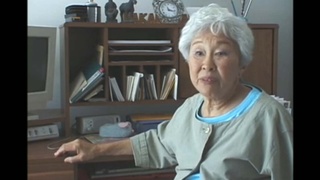Interviews
Unable to work when the war broke out
I applied at the Los Angeles County Hospital for an obstetrical residency. So I was there a while and of course they fired everyone of Japanese ancestry when the war broke out. So I couldn’t even…I barely started and had to leave. So I went to Seaside Memorial Hospital in Long Beach and I was there about a month and then they made everybody from Terminal Island and the beach area to go to camp at Santa Anita Race Track. So there I was in the horse stables, where you can still smell the manure and they gave us these straw mattresses, well we had to fill it with straw you know. And that’s where we were.
Date: March 31, 2005
Location: California, US
Interviewer: Gwenn M. Jensen
Contributed by: Watase Media Arts Center, Japanese American National Museum
Explore More Videos

Her experience as a Japanese-American schoolchild in Oceanside, California, after the bombing of Pearl Harbor
(1924-2018) Artist and playwright.

Making the decision to resist the draft
(b. 1923) Nisei from Washington. Resisted draft during WWII.

Discharged from the U.S. Army after Pearl Harbor
(b. 1918) Founder Azumano Travel

Closing the Japanese school and deportation (Spanish)
(b. 1932-2016) Peruvian painter

Death of sister in October 1942
(1915 - 2011) Nisei florist who resettled in New York City after WW II. Active in Japanese American civil rights movement

Living conditions in prison while serving time for resisting the draft
(b. 1925) Draft resister

Talking to children about decision to resist the draft during World War II
(b. 1925) Draft resister

Reflecting on Japanese Americans' response to incarceration
(b. 1925) Draft resister

An emotional response from mother upon talking about incarceration experience
(b. 1946) Lawyer

Encountering a train full of Japanese Americans being transported to a concentration camp
(b. 1923) Chick sexer


Sneaking out of the Hastings Park camp during World War II
(b. 1928) Doctor. Former Chair of the Japanese Canadian Redress Foundation.

Government's permission to publish Japanese newspaper in Canada during World War II
(b. 1928) Doctor. Former Chair of the Japanese Canadian Redress Foundation.

Government urged Japanese Canadians to go to Japan
(b. 1928) Doctor. Former Chair of the Japanese Canadian Redress Foundation.

